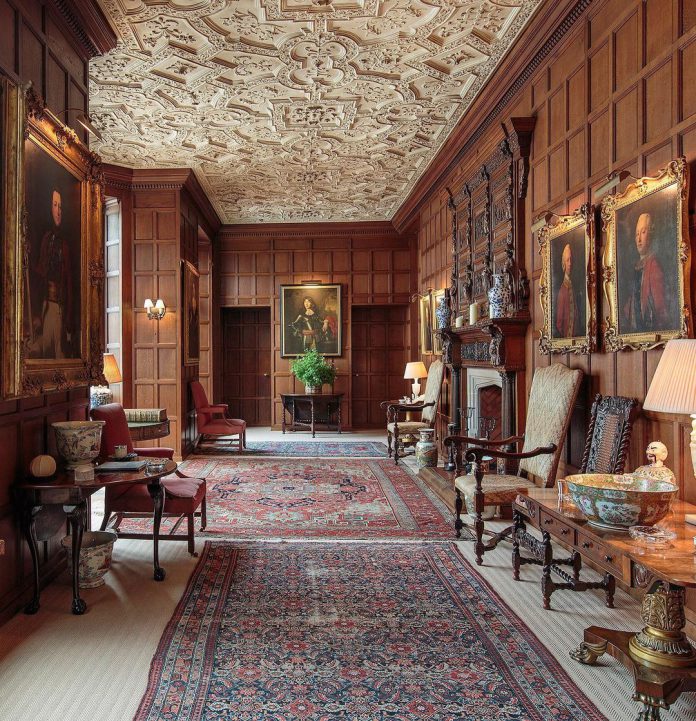Persian carpets may be traced to antiquity, so old is their existence that very little is known of the beginnings. These carpets have been exchanged as diplomatic gifts. An earliest mention is in the millennium-old Anabasis by Greek author Xenophon. In his notes, he describes in detail the artistry and designs of these carpets, while adding that they are mostly found in affluent households owing to their exorbitant prices. Their popularity rapidly spread across Asia and Europe.
During the second half of the first millennium, with the Islamic conquest of Persia, carpet making underwent dramatic changes, incorporating Islamic aesthetics. The carpets were woven in workshops run by experienced artisans, produced by royal court manufacturers.

The designs that originated under the reign of the Safavid rulers in 16th-century Persia have been known for their sophisticated embellishments and Islamic geometric patterns. The technical design aspect of the carpets underwent an overhaul during this period, so much so that the period is referred to as the “carpet design revolution era”. The initial design inspiration from the Timurid period miniature painting was shed for more curvilinear designs. They began to include large spirals and tendrils, floral and animal motifs.
In the second half of the second millennium, the tradition of carpet weaving witnessed a steady decline with the introduction of economical commercial designs.

WEAVING PERSIAN CARPETS
Every element of a Persian carpet reflects the opulence of Iran’s history and culture. The materials that go into crafting a carpet are of the finest quality. These carpets could, at times, be so intricate that it could take several years to put together even smaller ones. The process of weaving in some regions in Iran still remains similar to that of the bygone era of kings and queens. The reason it takes so long to make carpets is that much of the work is still done by hand. Weavers, mostly women, take great pride in their work. The work involves dyeing the wool and silk for the pile, creating unique patterns and then executing these on traditional looms. The most well-known carpet patterns have been from Isfahan from central Iran, Qom carpets from the north, Bidjar from the west, and the distinctive Gabbeh from the southwest.

VARIETIES OF PERSIAN CARPETS
Owing to their rich history and ubiquitous presence in Persia, carpets from different regions have their local folk designs. Some popular Persian carpet styles:
-
- Tabriz Carpets: These come from the Azerbaijan Province’s capital city, Tabriz. They are woven from high-quality wool-based raw materials. Tabriz carpets have been known for their diverse patterns, and often depict scenes like those of royal hunting expeditions. Antique Tabriz carpets command hefty prices and are mostly found in private collections of cultural museums.
-
- Heriz Carpets: Similar to the Tabriz carpets, these carpets also originate from the East Azerbaijan province in Northern Iran. The distinguishing factor of these carpets is their bold patterns and vibrant colours. They usually come with a large medallion in the centre and a sizable set of corner pieces.
-
- Kashan Carpets: These have signature patterns of floral fields with a medallion in the centre and a set of unique designs for the corners. Intricate patterns are woven in lively colours, like ivory, ruby red, and sapphire blue.
-
- Gabbeh Carpets: These are woven by Luri and Qashqai weavers that inhabit the Zagros Mountains in northwestern Iran. The handspun wool brings a coarse, thick quality to the carpets. They have simple designs, depicting scenes from tribal life in the hills. The dye colours are sourced from natural pigments.
-
- Isfahan Carpets: These are high-quality pieces that get woven using wool on silk. They have dense textures, with relatively higher knot counts. These also tend to come with intricate designs that inculcate symmetry and balance.
 THE INDIAN CONNECT
THE INDIAN CONNECT
Like Persia, India too has a remarkable carpet manufacturing legacy. The Indian version of the centuries-old craft dates back to the 16th century. It is said that Persian carpet weavers, particularly from the Gabbeh region of Iran, had been commissioned by royal families in India to create carpets. In India, most of the carpet manufacturing takes place at Agra, Srinagar and Jaipur. The country has been most prominently known for its high-quality natural silk hand-knotted carpets that take design inspiration from their Iranian counterparts. The highlight among all hand-knotted varieties is the Indian Gabbeh. Today, India is the world’s largest producer and exporter of handmade carpets, exporting in excess of a billion dollars.
 GUIDE TO PURCHASING AN EXQUISITE PERSIAN CARPET
GUIDE TO PURCHASING AN EXQUISITE PERSIAN CARPET
General considerations that you will have to go over would include the price range and the ability to withstand different levels of heat. Some people might like region-specific patterns or certain colours and sizes. Naiyara Rahman of Insigne Carpets, a leading Indian manufacturer of carpets, shares her views:
-
- Price: Persian carpets are expensive. But if you come with a good understanding of your requirements, you will be able to purchase a piece that proves money’s worth. Prices generally vary along one important aspect: the weaving. Hand-made carpets are costlier. Intricate weaves in hand-made carpets could take decades of unrelenting attention, hence the steep prices.
-
- Durability: Their durability greatly depends upon the material that goes into making the carpets. For example, wool-based carpets can take on rough usage without losing their radiance. On the other hand, silk, a more polished alternative, might take much more effort to maintain if put to use in a similar way. On the whole, if maintained with care, Persian carpets generally tend to last for a long time.
-
- Patterns: Each region of Iran has its own unique design aesthetic. Each element in a carpet should be carefully considered, in the context of your room’s ambience. For example, if you are looking for more tribal elements, carpets from Gabbeh, Bakhtiari, and Balouchi might appeal to you. Similarly, for carpets imbued with aspects of rural life, regions like Heriz, Hamadan and Abadeh might be better. For a more cosmopolitan option, carpets from Kashan, Tabriz, and Nain would be better.
-
- The Colour Palette: Many Persian carpets come in soothing, earthy colours. If you’re looking for subdued hues, then a mix of colours like aqua-blue, spring green might be good choices. But if you want standard carpets, then you may choose from the rich bouquet of vibrant colours these carpets are famous for: Ruby red, sapphire blue, cobalt green.
-
- Authenticity: You should look carefully for details that will attest to the authenticity of your purchase. A rapid increase in popularity has meant that markets around the world are flooded with counterfeits.





